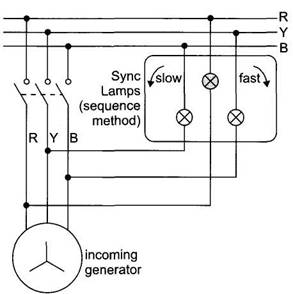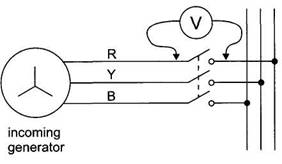Question
With reference to the parallel
operation of electrical generators:
(a) Explain how two alternators may
be synchronised;
(b) State
how two alternator may be synchronised if the synchroscope
is defective;
(c) Explain how synchronisation may
be performed without any switchboard instrumentation;
(d) Explain the likely consequences
if the timing of synchronisation is ineptly executed.
The various important conditions
are.
The voltage of the incoming machine
must be equal to that of bus bar.
The frequency of the incoming
machine must be same as that of the bus bar frequency.
The e.m.f
of the incoming machine must be in phase with the bus bar voltage.
The phase sequence of eh incoming
machine must be similar to that of the bus bar and switching arrangements must
be such that, like phase of the machine and bus bar are connected when
paralleling procedure is completed.
With the help of synchroscope and voltmeter, synchronisation is carried out.
When synchroscope pointer rotates slowly in clockwise
direction and comes to 1100 clock position close the breaker and switch off synchroscope.
(b) With 3 lamp method
synchronisation of 2 generator can be carried out.
When lamps rotate in clockwise direction, top lamp is dark and bottom 2 lamps
are equally bright, close the breaker.

Synchronising
with three lamps.
(c)

Connect a voltmeter as shown,
across one pole of the open incoming generator circuit breaker. This procedure
is more easily (and safely) performed at the synchroscope
terminals behind the door of the synchronising panel at the front of the main
switchboard. Check the circuit diagrams before such testing.
Adjust the generator speed until
the voltmeter very slowly fluctuates from zero to maximum.
Close the breaker when the
voltmeter indication passes through zero. Note, for this operation, an analogue
(pointer and scale) meter is easier to follow than a digital type.
(d) At the instant of closing the
breaker, the voltage phase difference causes a large circulating current
between the machines which produces a large magnetic force to pull the
generator voltages (and field poles) into synchronism. This means rapid
acceleration of one rotor and deceleration of the other. The large forces may
physically damage the generators and their prime-movers and the large circulating
current may trip each generator breaker. Blackout, danger
Voltage phase difference.
Large
circulating current.
Large
magnetic force. – pull the generator voltage into synchronisim.
Rapid
acceleration of one rotor and de-acceleration of other.
Large force may damage generator.
Large current may trip each
generator.
Blackout.
Six damages that may be caused when
machine are incorrectly synchronised
Damage to
coupling.
Damage to
generator windings.
Damage to
prime mover.
Damage to
electrical circuit due to high power surge.
Stator core
damage.
Huge surge current could damage
stator winding.